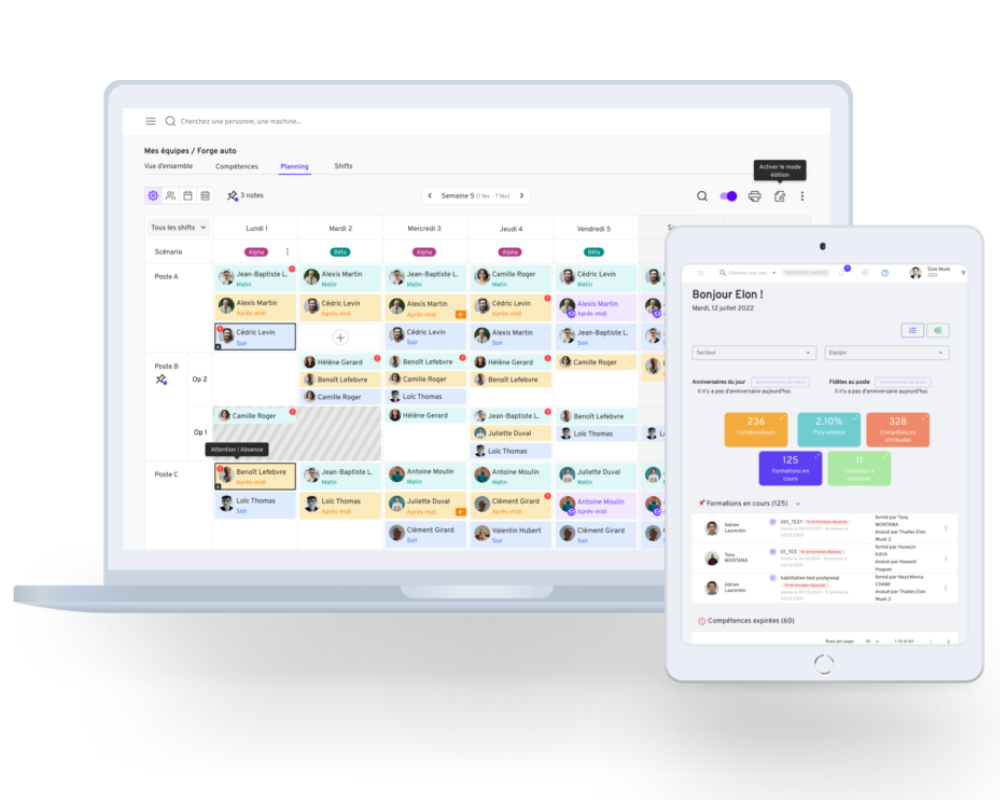Introduction
In the factories, Excel reigns supreme when it comes to managing production schedules. This faithful ally of production managers has long been the default solution, enabling rapid creation of planning tables without additional software investment. A file, a few formulas and you've got an Excel production schedule.
Yet, as production demands intensify and operations become more complex, the limits of this approach become glaringly apparent. Managers spend hours juggling cells, duplicating information and correcting errors. At a time when production agility is becoming a decisive factor in competitiveness, can we still afford to rely on generalist tools for something as strategic as production planning?
1. The challenges of Excel production planning
Time wasted manually managing the Excel production schedule
The day-to-day reality of a production manager using Excel to manage his schedules is often time-consuming. Team leaders spend many hours a week managing their Excel production schedules. A significant proportion of this time is devoted to manual adjustments - modifying assignments, updating availabilities, checking operators' skills. This precious time could be invested in coaching teams, improving processes or solving operational problems.
Multiplication of files and loss of information
Another major challenge is the proliferation of Excel files. On a single production site, it's not uncommon to find 10, 20 or even 50 different Excel files to manage schedules, skills, training and authorizations.
This fragmentation inevitably leads to problems of synchronization and access to information. When an operator validates a new skill, the information has to be passed on manually to several files - training, skills, planning... The consistency of this data often depends on the rigor of one person, creating a critical point of failure.
What's more, when several users have to work on the same document, contradictory versions can circulate, making collective management complex and a source of errors.
Risks of error and their consequences
Excel files, especially when they are complex and involve numerous macros, are prone to errors. A simple formula incorrectly copied, a cell incorrectly referenced or an update forgotten can have serious consequences.
These errors can lead to situations where an operator is assigned to a position for which he or she does not have the required skills or authorizations. The implications are manifold:
- Safety risks for operator and colleagues
- Quality problems on manufactured products
- Regulatory non-compliance, particularly critical in regulated sectors (pharmaceutical, agri-food, aeronautics)
These risks are not theoretical. In several plants, incidents have been directly linked to assignment errors resulting from poor management of skills in the Excel production schedule.
Limits to absenteeism and last-minute changes
Anyone who has managed a production team knows the impact of a morning call announcing the absence of an operator. With an Excel Production Schedule, the manager must :
- Identify impacted operations
- Manual search for potential replacements
- Check their skills and qualifications for the position
- Ensure their availability
- Modify the schedule accordingly
- Communicate these changes to all stakeholders
This process, repeated every time something unexpected happens, takes up a considerable amount of time and diverts attention from more strategic issues. In an environment where absenteeism can affect 5 to 10% of the workforce on a daily basis, responsiveness becomes a critical issue that traditional tools struggle to support.
2. Impact on industrial performance
Excel production planning: Impact on team productivity and manager time
Excel production planning doesn't just penalize production managers. It affects the entire industrial value chain.
On the operator side, the lack of visibility of updated schedules wastes time. Each time they take up a shift, they have to consult the team leader to find out their assignment, creating unnecessary dependency and communication bottlenecks. This waiting time translates directly into lost production minutes.
Managers, for their part, are seeing their administrative workload increase, to the detriment of their supervisory and continuous improvement functions. A production manager at an automotive supplier reported: "Before, I used to spend 60% of my time on administrative tasks linked to planning. That's not why I chose this job.
This has a direct impact on overall site productivity. Excessive time spent on planning means resources diverted from value creation.
Difficulties in keeping track of skills
The traceability of skills and authorizations is a critical issue for industry, particularly in regulated sectors. With Excel, this traceability relies on a documentary discipline that proves difficult to maintain over time.
When an operator is trained for a new position, how can we ensure that this information is properly recorded, dated and accessible? in the event of an audit ? How can I effectively track the expiry dates of regulatory authorizations? How can we ensure that proof of training is properly archived and easily retrievable?
These questions, far from being anecdotal, represent a real headache for quality and production managers. Faulty traceability can lead to non-compliance during customer or regulatory audits, with potentially serious consequences for the company.
Barriers to operator versatility
Visit operator versatility is a major driver of flexibility and resilience for industrial sites. However, its management via Excel has considerable limitations.
Without a clear, up-to-date view of available skills, managers tend to assign operators to jobs they already know, rather than develop new skills. This approach, while understandable in a context of production pressure, progressively limits the team's ability to adapt.
What's more, without dashboard effective in keeping pace with the evolution of multi-skilling, training efforts are not always directed towards the most critical needs.
Complexity of audits and controls
Quality audits, whether internal or external, always represent a tense moment for industrial teams. With an Excel-based production schedule, preparing for these audits becomes particularly laborious.
A quality manager in the pharmaceutical industry recently commented: "For each audit, I had to assemble dozens of Excel files scattered across different departments. It took me almost a full week to prepare the evidence relating to skills and authorizations."
This complexity is not just a matter of convenience; it can have serious implications in terms of compliance. Failure to quickly demonstrate that an operator was properly trained and empowered for a specific task can lead to major non-compliances, particularly in highly regulated industries.
The difficulty of quickly extracting consolidated information from a fragmented Excel production schedule also makes it difficult to analyze trends and proactively identify risks, both of which are essential to an effective quality approach.
3. What are the alternatives for overcoming the limitations of an Excel production schedule?
The benefits of a specialized digital solution
Faced with Excel's limitations, many industrial sites are turning to specialized digital solutions for managing their production schedules. These tools, designed specifically to meet the needs of industrial environments, offer an integrated approach that goes far beyond the capabilities of a general-purpose spreadsheet.
The main advantage of these solutions lies in their ability to centralize information and create links between the various dimensions of production team management: skills, schedules, trainingauthorizations. This 360° vision automates numerous tasks and secures processes.
Unlike Excel, these tools are also designed to be used by different user profiles, from the operator who consults his schedule until director analyzing versatility KPIs, through to the team leader who manages assignments on a daily basis.
Concrete time savings for production teams
Experience shows that considerable time is saved when switching from Excel to a specialized scheduling solution.
For example, at Shiseido, a famous Japanese cosmetics house, the switch to a digitalized solution has transformed the day-to-day management of schedules. The 4 division managers who were adjusting the Excel production schedule on a daily basis have seen their workload considerably lightened. In concrete terms, more than 14 Excel files were eliminated, representing a time saving of 4 hours per week for these managers.
These gains can be explained in particular by :
- Automated assignments based on skills and availability
- Real-time information updates, eliminating the need to re-enter data
- Direct access to relevant information without having to consult multiple files
- Simplified adjustment to unforeseen circumstances
Improving skills management and training
Beyond planning, digital solutions are transforming the management of skills and training, two dimensions intimately linked to the performance of production teams.
The main improvements concern :
- Skills visibility Team leaders and training managers have a clear, up-to-date view of available skills, making it easier to identify priority training needs.
- Training follow-up : The entire training process can be digitized, from launch to evaluation, with automatic notifications for the various stakeholders.
- Managing regulatory authorizations The software's expiration dates are automatically tracked, with alerts sent to managers several months in advance, enabling them to anticipate any necessary retraining.
- Developing versatility Dedicated dashboards can be used to monitor versatility and set precise targets, as illustrated by the experience of an aeronautical component manufacturer who saw its versatility rate increase by 20% after implementing such a system.
Securing assignments and regulatory compliance
A fundamental aspect of specialized digital solutions is their ability to secure assignments and guarantee regulatory compliance.
In concrete terms, these systems can :
- Prevent the assignment of an operator to a position for which he or she does not have the required skills or authorizations.
- Alert on impending expiry of critical clearance
- Keep a complete history of assignments and training, a crucial element in the event of an audit
- Automatically generate compliance reports
These features are particularly valuable in highly regulated industries. As a quality manager in the pharmaceutical industry explains: "Audit preparation time has been cut by a factor of three. All information is centralized and easily accessible.
4. Making a successful transition from Excel to a digital solution
Key stages in a successful deployment
The transition from an Excel production schedule to a specialized digital solution represents a significant change that requires a structured approach. Based on our experience, we have identified several key steps for a successful deployment:
- Diagnosis of existing facilities Mapping current processes, identifying Excel files in circulation and understanding the flow of information between different departments.
- Defining objectives Clarify expectations of the new solution, whether in terms of time savings, process security or improved traceability.
- Initial perimeter selection The first step is to define an initial deployment perimeter, often limited to a workshop or production line, to facilitate ownership.
- Digitizing master data Transfer essential information (skills, authorizations, organization chart) to the new solution.
- User training Train different categories of users, adapting content to their specific needs.
- Accompanied start-up Accompany users as they take their first steps with the tool, to reassure them and quickly resolve any questions they may have.
- Gradual expansion Extend the scope to other workshops or functionalities once the initial deployment has stabilized.
How to win team support
The success of a project to digitize production schedules depends to a large extent on the support of the teams, particularly the team leaders who will be the first users of the solution.
There are several ways to facilitate this adoption:
- Involving users right from the design phase Take into account their specific needs and constraints, so that the solution meets their real expectations.
- Highlight concrete benefits for each user category:
- For team leaders: time-saving, simplified schedule adjustments
- For operators: better visibility of their assignments, recognition of their skills
- For training managers: easier tracking of training courses
- For managers: reliable data to drive performance
- Choose intuitive, ergonomic solutions User experience is a key factor in adoption, particularly in environments where IT is not always used on a daily basis.
- Communicate regularly on progress of the project and highlight its early successes.
Measuring return on investment
Investment in a digital production scheduling solution must naturally be measured against the benefits it brings. Several indicators can be used to measure this return on investment:
- Time saved by management teams on schedule management
- Reduced assignment errors and related incidents
- Increased versatility teams
- Reduced preparation time audits
- Reduced use of temporary staff through better use of in-house skills
Beyond the direct financial aspects, there are other benefits that are more difficult to quantify:
- Improving team satisfaction
- Reducing the risk of non-compliance
- Improved responsiveness to production contingencies
- Preserving the company's know-how
These elements, although not always included in formal ROI calculations, contribute significantly to the creation of value for the company.
Conclusion
Excel production planning, long considered a satisfactory solution, is now showing its limitations in the face of the growing demands of industrial environments. Time wasted, risk of errors, traceability difficulties... the consequences of Excel-based management weigh heavily on the overall performance of production sites.
Specialized digital solutions offer a credible alternative, with tangible benefits in terms of saving time, improving skills management and securing processes. All with relatively rapid deployment and measurable returns on investment.





